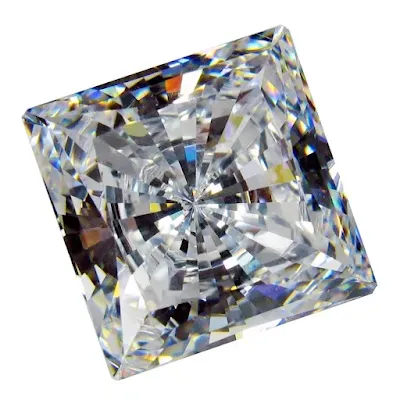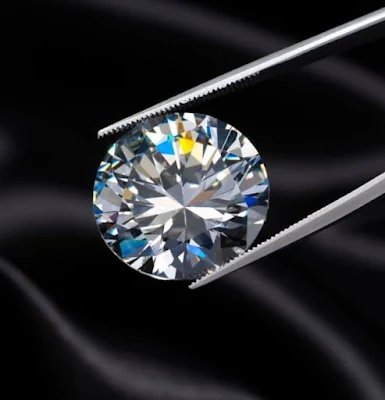Simulated Diamonds: Types, Prices, Are They Real Diamonds
Simulated Diamonds: A Comprehensive Guide to Sparkling Alternatives. Simulated Diamonds: What Are Simulated Diamonds, Types, Prices, and Are They Real Diamonds?
Diamonds have long been coveted for their dazzling beauty and symbolism, but in recent years, a new player has entered the spotlight – simulated diamonds. These stunning gems offer an alluring alternative to traditional diamonds, capturing the essence of luxury and elegance without the hefty price tag.
What is Simulated Diamond
A simulated diamond, also known as a diamond simulant, is defined as any gemstone or material, whether engineered or naturally occurring, that is crafted to imitate the appearance of a diamond while differing in chemical composition. These are stones that look like diamonds but are not diamonds; they are made from different materials and are typically created in labs or factories rather than being mined from the earth. Alternative terms include diamond imitations or diamond alternatives.
Are Simulated Diamonds Real Diamonds
Simulated diamonds are not real diamonds. They are diamond look-alikes crafted from entirely different materials, meaning their chemical composition, physical properties, and how they're made are distinct from natural diamonds. However, the visual similarity can be so striking that many would be hard-pressed to tell them apart without specialized equipment. While they don't share the geological history of natural diamonds, simulated diamonds possess their own allure and value, making them stunning alternatives in the world of jewelry.
.jpeg) |
| The Most Common Types of Simulated Diamonds |
Types of Simulated Diamonds
The most common types of simulated diamonds are:
Cubic Zirconia (CZ)
 |
| Cut Cubic Zirconia (CZ) |
Cubic Zirconia (CZ) is a popular diamond simulant known for its impressive brilliance and affordability. CZ is synthesized from zirconium dioxide (ZrO₂) and is meticulously cut and polished to mimic the facets of a diamond. It is very hard, with a Mohs hardness of 8-8.5 (diamonds are at 10), and has a high refractive index that contributes to its significant sparkle. While not as hard as diamonds, CZ is durable enough for everyday wear. It closely resembles diamonds in both brilliance and fire but lacks the depth and light refraction of natural diamonds. CZ is typically flawless and can be produced in various colors, offering a clear and vibrant appearance.
Cost: Affordable and widely available.
Moissanite
 |
| Cut Natural Moissanite |
Moissanite, although naturally occurring, is most often lab-created for use as a simulated diamond alternative. It is renowned for its exceptional brilliance and fire, often surpassing that of natural diamonds. Moissanite's composition and optical properties closely resemble those of diamonds, making it a sought-after choice for jewelry. Moissanite is more expensive than cubic zirconia (CZ), but significantly less than natural diamonds. It is colorless and has a very high refractive index, giving it a brilliant sparkle. This gem is also very durable, withstanding everyday wear and tear, due to its composition of silicon carbide and a hardness of 9.25 on the Mohs scale. Moissanite stands out for its high brilliance and a unique 'rainbow effect' under light, which can make it appear even flashier than a diamond. While it shares some optical properties with diamonds, moissanite’s extra fire and brilliance—the dispersion of light into colors—create a distinct look, often catching the eye with its colorful sparkle.
Cost: More expensive than CZ but still much cheaper than a diamond.
White Sapphires
.jpg) |
| Cut Natural White Sapphires |
White sapphires are another option for creating simulated diamonds. These gemstones exhibit a beautiful sparkle and are often used as accents or center stones in engagement rings and other jewelry pieces.White sapphire is colorless and has a high refractive index, which gives it a beautiful sparkle. It is also very hard and can withstand everyday wear and tear.
Cost: Typically more affordable than diamonds but more expensive than CZ.
Spinel
.jpg) |
| Cut Natural Spinel |
Spinel is a magnesium aluminum oxide mineral available in various colors, including white. It has a Mohs hardness of 7.5-8, which makes it softer than diamond and less brilliant. White spinel is more affordable than many other simulants but provides a unique, gentle sparkle that some may find appealing for a vintage or understated look.
Cost: Generally affordable, though prices vary depending on the quality.
Zircon
 |
| Cut white Zircon |
Zircon is a natural mineral made of zirconium silicate. With a hardness of 6-7.5, it is softer than most other simulants, so it’s more prone to scratches and chipping. Zircon, however, has a high dispersion, which creates good sparkle and often a slightly warm tint under certain lighting. It can resemble a diamond quite well, but it may show more noticeable color hues depending on the angle and lighting.
Cost: Affordable, though natural zircon is more expensive than CZ.
.jpg) |
Types of simulated diamonds: cubic zirconia, moissanite, white sapphire, and zircon. |
How Are Simulated Diamonds Created
Simulated diamonds are crafted from different materials to resemble diamonds, each with unique creation processes:
Cubic Zirconia (CZ): Made by heating zirconium dioxide with stabilizers. The cooled crystals are cut and polished to achieve a flawless, colorless look with diamond-like sparkle.
Moissanite: Created by combining silicon and carbon under high heat and pressure to form silicon carbide crystals, which are then faceted. Moissanite has intense brilliance and a rainbow-like sparkle.
White Sapphire: Made from corundum (aluminum oxide), synthesized using flame fusion. The result is a clear but softer stone with a subtler sparkle than diamond.
Spinel: Made of magnesium aluminum oxide, created using flame fusion. White spinel is durable and offers a gentle sparkle, often used in vintage-style jewelry.
Zircon: A natural mineral, typically mined and heat-treated to enhance clarity. Zircon has a high fire, giving it a lively sparkle, though it may show color in certain lighting.
Simulated diamonds Price
The prices of simulated diamonds vary depending on the type of diamond, the size of the diamond, and the quality of the diamond. CZ is the most affordable type of simulated diamond, while moissanite and white sapphire are more expensive.
For example, a 1-carat CZ can cost as little as $10, while a 1-carat moissanite can cost up to $500. A 1-carat white sapphire can cost anywhere from $200 to $1,000.
- Cubic Zirconia (CZ) Price Range: $10 - $100 per carat
- Moissanite Price Range: $300 - $800 per carat for standard moissanite, with premium options reaching up to $1,000 per carat
- White Sapphire Price Range: $50 - $200 per carat
- Spinel Price Range: $50 - $150 per carat for synthetic spinel
- Zircon Price Range: $75 - $200 per carat
It is important to note that these are just general price ranges. The actual price of a simulated diamond will depend on the specific retailer, the quality of the diamond, and the current market conditions.
Simulated Diamonds Compare to Natural Diamonds
Simulated diamonds share visual similarities with natural diamonds, including their sparkle and brilliance. However, there are key differences between the two:
Composition: Simulated diamonds are made from different materials than natural diamonds. While diamonds are composed of carbon atoms arranged in a crystal lattice, simulated diamonds are often made from cubic zirconia, moissanite, or white sapphires.
Hardness: Natural diamonds are renowned for their exceptional hardness and durability, ranking as the hardest mineral on the Mohs scale. Simulated diamonds, while durable, may not match the same level of hardness as natural diamonds.
Value: Simulated diamonds are generally more affordable than natural diamonds, making them an attractive option for those seeking high-quality gemstones without the premium price.
.jpeg) |
| Famous Simulated Diamond Cuts Used in jewelry |
Are Simulated Diamonds Ethical
One of the compelling reasons many individuals choose simulated diamonds is the ethical aspect. Natural diamond mining has been associated with environmental concerns, as well as ethical issues related to labor practices in some regions. Simulated diamonds offer an ethical choice for consumers who prioritize sustainability and responsible sourcing.
How Do You Care for Simulated Diamond Jewelry
Caring for simulated diamond jewelry is similar to caring for natural diamond pieces. To maintain their brilliance and shine, follow these tips:
Regular Cleaning: Clean your simulated diamond jewelry with mild soap and warm water using a soft brush. Rinse thoroughly and pat dry.
Avoid Harsh Chemicals: Avoid exposing your jewelry to harsh chemicals, such as chlorine or bleach, as these can damage the gemstone and setting.
Safe Storage: Store your simulated diamond jewelry separately in a soft pouch or jewelry box to prevent scratches and damage.
Conclusion
Simulated diamonds are captivating alternatives to natural diamonds, offering a stunning and ethical choice for those seeking the allure of diamonds without the associated costs and concerns. With their dazzling brilliance and affordable price points, these gems are redefining the world of fine jewelry. Whether you're looking for a dazzling engagement ring, a glamorous necklace, or elegant earrings, simulated diamonds are a remarkable option that combines beauty, affordability, and ethical consciousness.

%20(1).webp)






